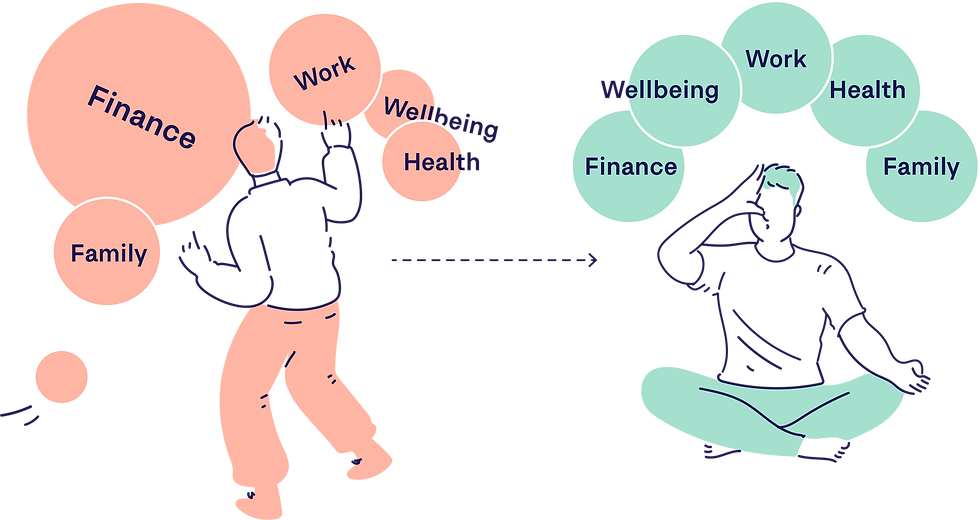Reclaim Focus and Leadership Impact: From Split Attention to Deep Concentration
- Ron Adiel

- Aug 5
- 4 min read
Ever feel like your mind is running 27 browser tabs at once — switching endlessly, never fully loading?
That’s what split attention feels like. And it’s costing you dearly, often without you realizing it.
For today’s executive, tab-switching often shows up as “multitasking” and is mistaken for productivity. But it’s actually doing the opposite: fragmenting your cognitive resources, weakening your presence, and degrading your ability to lead.
We live in an age where attention is no longer ours by default. It’s hijacked, monetized, and relentlessly triggered. Unless we reclaim it, concentration will continue to erode.
Split attention may give the impression of productivity — but it erodes it from within
The Hidden Costs of Split Attention
The ability to concentrate deeply — on one idea, one task, one conversation — is becoming a rare executive skill. Yet it’s more critical than ever.
Smartphones, team messages, constant notifications, and relentless commercial triggers are shaping a new default mode: split attention. We’re conditioned to react rather than focus, and in high-growth environments, that reactivity often feels necessary.
The impact runs deeper than most realize. Fragmented attention steadily erodes performance in three essential ways:
Productivity declines. Multitasking delays task completion, increases errors, and drains focus. Research shows multitasking can reduce productivity by up to 40%*.
Wellbeing suffers. You become reactive. Your buttons get pressed. Emotional fatigue escalates.
Leadership presence erodes. People feel your distraction. You’re in meetings but not fully there. Trust diminishes.
Over time, this fragmentation becomes a habitual default. Your brain, now accustomed to switching, resists stillness. Depth begins to feel uncomfortable.
This is the Monkey Mind in action — restless, scattered, always jumping to the next trigger.
That mental scattering shows up in conversations. Picture yourself in discussion with a colleague while your mind loops back to an earlier client email.
Your attention is split — and two things happen:
You stop truly listening. Your brain fills in the gaps with assumptions, often inaccurately.
You lose the ability to deepen attention — so real concentration never forms.
In this diluted state, connection breaks down, and so does leadership.
Split attention doesn’t just slow you down — it trains your brain to avoid depth
How Attention Becomes Concentration and Why That Changes Everything
Split attention doesn’t just scatter your focus — it blocks the very development of concentration. And without concentration, strategy weakens, creativity stalls, and leadership impact fades.
In Buddhist psychology, attention becomes concentration through five progressive stages:
Pure Attention: Objective observation, without judgment
Examination: An active, curious inquiry into the object of attention
Rapture: A subtle delight in the process of discovery
Joy: A sense of peaceful fulfillment in the knowing
Deep Concentration: A unified, one-pointed focus
Each stage builds on the last — but even a brief distraction resets the process.
Every time your mind switches, you start from zero again. You lose momentum. You waste energy. And you never arrive at the deep, rewarding focus that powers innovation and presence.
But when attention is sustained, something surprising happens: it becomes uplifting.
Concentration itself generates joy — not as a reward, but as a byproduct. It becomes its own source of wellbeing.
Reframing Attention as Your Core Resource
Many leaders think time is their scarcest resource — but time without attention is simply wasted.
That’s why attention, not time, is your most valuable resource.
Attention is what gives time its value — it brings presence, clarity, and energy to every hour you invest.
You don’t need more time — you need more attention
The arc of Attention → Concentration → Executive State is what truly drives performance:
Attention is the gatekeeper.
Concentration is the power zone.
Executive State — rational thinking, emotional control, strategic clarity — flourishes when concentration deepens.
You can strengthen this arc through intentional practice — especially meditation, which directly trains sustained attention.
A simple breath meditation is more than stress relief. It’s a training ground for concentration, teaching your brain to sustain attention, regulate reactivity, and strengthen the muscle of mental stillness.
The result? Clearer decisions. Deeper focus. More effective leadership.
The Leadership Edge of Concentration
What changes when a leader builds real concentration?
Everything.
They enter deep work states, where innovation and strategy flourish.
They preserve mental energy instead of draining it in constant micro-switches.
They project calm and presence, instantly felt by their teams.
They get more done, in less time, with higher quality.
And critically — they’re perceived as more effective, grounded, and inspiring.
This isn’t theory. It’s a trainable skill at the center of the Lifetime Evolution Program.
As reported by participants across cohorts:
“Higher productivity and sharper decisions — with half the mental energy.”
Here’s how to begin the shift:
Awareness: Track where your attention goes. Notice the distractions.
Anchoring: Practice returning to the breath, or single-tasking.
Strengthening: Protect larger focus windows. Build concentration like a muscle.
As your attention deepens, so does your leadership. You no longer operate from surface reactivity — but from inner coherence.
Attention Is Your Leverage Point
You don’t need another time hack.
You need to reclaim your attention.
Ask yourself:
Where is your attention leaking? Where is it split?
What would shift if you focused it, with depth and intention?
Where are you mistaking mental busyness for leadership presence?
Concentration is the gateway to presence. And presence is the heart of leadership.
Ready to strengthen the one resource that magnifies all others?
Discover how the Lifetime Evolution Program helps executives train attention, deepen concentration, and lead with clarity.
(*) University of Florida, The Multitasking Mirage, 2021
About the Author
Ron Adiel, PhD, empowers CEOs, Founders, and CXOs to achieve holistic transformational growth through the Lifetime Evolution Program, which integrates executive leadership expertise, psychology, and neuroscience.


